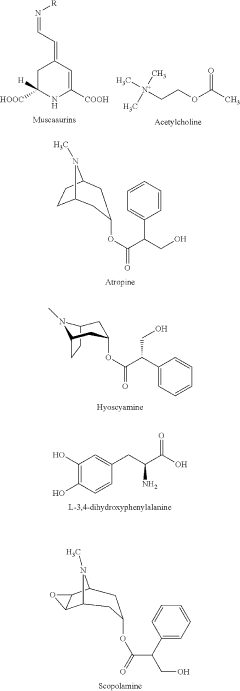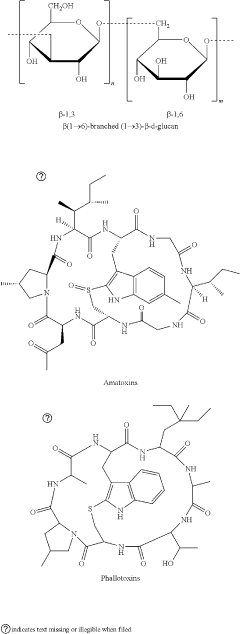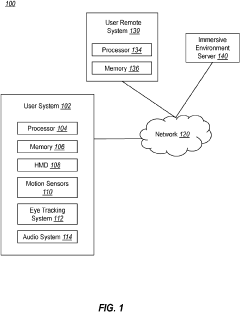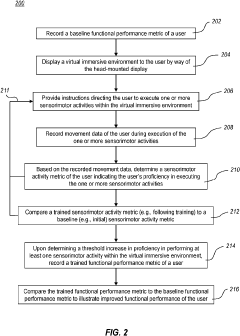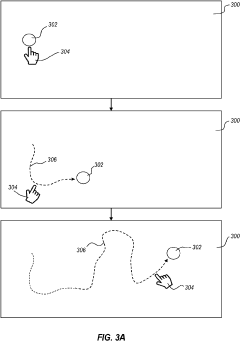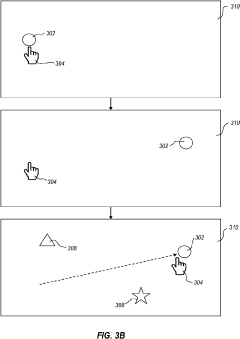Muscimol and Its Influence on Sensorimotor Integration
JUL 4, 20259 MIN READ
Generate Your Research Report Instantly with AI Agent
Patsnap Eureka helps you evaluate technical feasibility & market potential.
Muscimol Background and Research Objectives
Muscimol, a potent GABA-A receptor agonist, has been a subject of scientific interest for decades due to its unique pharmacological properties and potential therapeutic applications. Derived from the Amanita muscaria mushroom, this compound has played a crucial role in neuroscience research, particularly in the study of inhibitory neurotransmission and sensorimotor integration.
The historical context of muscimol research dates back to the mid-20th century when scientists first isolated and characterized the compound. Initially, muscimol was primarily studied for its psychoactive effects, which were attributed to its ability to modulate GABAergic signaling in the central nervous system. As research progressed, the focus shifted towards understanding the compound's specific mechanisms of action and its potential applications in neurological and psychiatric disorders.
In recent years, the scientific community has witnessed a resurgence of interest in muscimol, driven by advancements in neuroscience and a growing appreciation for the complexity of sensorimotor integration. This renewed focus has led to the exploration of muscimol's effects on various aspects of neural processing, including motor control, sensory perception, and cognitive function.
The primary objective of current muscimol research is to elucidate its influence on sensorimotor integration, a fundamental process that coordinates sensory input with motor output. This area of study is particularly relevant given the critical role of sensorimotor integration in everyday activities and its impairment in various neurological conditions. By investigating muscimol's effects on this process, researchers aim to gain insights into the underlying neural mechanisms and potentially develop novel therapeutic strategies.
Specific research goals include understanding how muscimol modulates neural activity in sensorimotor circuits, examining its effects on motor learning and adaptation, and exploring its potential in treating disorders characterized by sensorimotor dysfunction. Additionally, there is a growing interest in developing more targeted and selective muscimol-based compounds that could offer improved therapeutic benefits with reduced side effects.
The technological evolution in neuroscience research methods has significantly contributed to advancing muscimol studies. High-resolution imaging techniques, optogenetics, and advanced electrophysiological recording methods now allow for more precise investigation of muscimol's effects at cellular and circuit levels. These technological advancements are expected to drive future breakthroughs in understanding muscimol's mechanisms of action and its potential applications.
As research progresses, the scientific community anticipates that muscimol studies will continue to provide valuable insights into neural function and potentially lead to the development of new therapeutic approaches for a range of neurological and psychiatric disorders. The ongoing exploration of muscimol's influence on sensorimotor integration represents a promising frontier in neuroscience research, with implications that extend far beyond the compound itself.
The historical context of muscimol research dates back to the mid-20th century when scientists first isolated and characterized the compound. Initially, muscimol was primarily studied for its psychoactive effects, which were attributed to its ability to modulate GABAergic signaling in the central nervous system. As research progressed, the focus shifted towards understanding the compound's specific mechanisms of action and its potential applications in neurological and psychiatric disorders.
In recent years, the scientific community has witnessed a resurgence of interest in muscimol, driven by advancements in neuroscience and a growing appreciation for the complexity of sensorimotor integration. This renewed focus has led to the exploration of muscimol's effects on various aspects of neural processing, including motor control, sensory perception, and cognitive function.
The primary objective of current muscimol research is to elucidate its influence on sensorimotor integration, a fundamental process that coordinates sensory input with motor output. This area of study is particularly relevant given the critical role of sensorimotor integration in everyday activities and its impairment in various neurological conditions. By investigating muscimol's effects on this process, researchers aim to gain insights into the underlying neural mechanisms and potentially develop novel therapeutic strategies.
Specific research goals include understanding how muscimol modulates neural activity in sensorimotor circuits, examining its effects on motor learning and adaptation, and exploring its potential in treating disorders characterized by sensorimotor dysfunction. Additionally, there is a growing interest in developing more targeted and selective muscimol-based compounds that could offer improved therapeutic benefits with reduced side effects.
The technological evolution in neuroscience research methods has significantly contributed to advancing muscimol studies. High-resolution imaging techniques, optogenetics, and advanced electrophysiological recording methods now allow for more precise investigation of muscimol's effects at cellular and circuit levels. These technological advancements are expected to drive future breakthroughs in understanding muscimol's mechanisms of action and its potential applications.
As research progresses, the scientific community anticipates that muscimol studies will continue to provide valuable insights into neural function and potentially lead to the development of new therapeutic approaches for a range of neurological and psychiatric disorders. The ongoing exploration of muscimol's influence on sensorimotor integration represents a promising frontier in neuroscience research, with implications that extend far beyond the compound itself.
Neuroscience Market Demand Analysis
The neuroscience market, particularly in the realm of sensorimotor integration research, has been experiencing significant growth and demand in recent years. This surge is driven by the increasing prevalence of neurological disorders, the aging global population, and the growing interest in understanding brain function for both medical and technological applications.
The market for research tools and technologies related to muscimol and its effects on sensorimotor integration is expanding rapidly. Muscimol, a potent GABA-A receptor agonist, has become a valuable tool in neuroscience research due to its ability to modulate neural activity. Its application in studying sensorimotor integration has opened new avenues for understanding brain function and developing potential therapies for neurological disorders.
The pharmaceutical industry has shown a keen interest in this area, as insights gained from muscimol research could lead to the development of novel drugs for conditions such as Parkinson's disease, multiple sclerosis, and stroke rehabilitation. This has created a robust demand for specialized research equipment, chemical compounds, and analytical tools tailored to muscimol studies.
Academic institutions and research centers are also driving market demand, with an increasing number of neuroscience departments focusing on sensorimotor integration research. This has led to a rise in funding for projects exploring the effects of muscimol on neural circuits involved in motor control and sensory processing.
The biotechnology sector has responded to this demand by developing advanced imaging technologies and high-precision instruments for measuring neural activity in real-time. These tools are essential for understanding the complex interactions between muscimol and sensorimotor integration processes.
Furthermore, the growing field of brain-computer interfaces (BCIs) has created additional market opportunities. Researchers are exploring how muscimol-induced modulation of sensorimotor integration can improve BCI performance, potentially leading to more effective neuroprosthetics and rehabilitation technologies.
The market for muscimol-related research is not limited to traditional neuroscience applications. There is an emerging interest in its potential use in cognitive enhancement and mental health treatments, further expanding the market scope and driving innovation in drug delivery systems and targeted neuronal modulation techniques.
As the field progresses, there is an increasing demand for specialized data analysis software and artificial intelligence algorithms capable of interpreting the complex datasets generated by muscimol and sensorimotor integration studies. This has created new opportunities for software developers and data scientists in the neuroscience market.
In conclusion, the market demand for research on muscimol and its influence on sensorimotor integration is robust and multifaceted, spanning across pharmaceutical, academic, biotechnology, and technology sectors. The potential for groundbreaking discoveries and therapeutic applications continues to fuel investment and innovation in this dynamic area of neuroscience.
The market for research tools and technologies related to muscimol and its effects on sensorimotor integration is expanding rapidly. Muscimol, a potent GABA-A receptor agonist, has become a valuable tool in neuroscience research due to its ability to modulate neural activity. Its application in studying sensorimotor integration has opened new avenues for understanding brain function and developing potential therapies for neurological disorders.
The pharmaceutical industry has shown a keen interest in this area, as insights gained from muscimol research could lead to the development of novel drugs for conditions such as Parkinson's disease, multiple sclerosis, and stroke rehabilitation. This has created a robust demand for specialized research equipment, chemical compounds, and analytical tools tailored to muscimol studies.
Academic institutions and research centers are also driving market demand, with an increasing number of neuroscience departments focusing on sensorimotor integration research. This has led to a rise in funding for projects exploring the effects of muscimol on neural circuits involved in motor control and sensory processing.
The biotechnology sector has responded to this demand by developing advanced imaging technologies and high-precision instruments for measuring neural activity in real-time. These tools are essential for understanding the complex interactions between muscimol and sensorimotor integration processes.
Furthermore, the growing field of brain-computer interfaces (BCIs) has created additional market opportunities. Researchers are exploring how muscimol-induced modulation of sensorimotor integration can improve BCI performance, potentially leading to more effective neuroprosthetics and rehabilitation technologies.
The market for muscimol-related research is not limited to traditional neuroscience applications. There is an emerging interest in its potential use in cognitive enhancement and mental health treatments, further expanding the market scope and driving innovation in drug delivery systems and targeted neuronal modulation techniques.
As the field progresses, there is an increasing demand for specialized data analysis software and artificial intelligence algorithms capable of interpreting the complex datasets generated by muscimol and sensorimotor integration studies. This has created new opportunities for software developers and data scientists in the neuroscience market.
In conclusion, the market demand for research on muscimol and its influence on sensorimotor integration is robust and multifaceted, spanning across pharmaceutical, academic, biotechnology, and technology sectors. The potential for groundbreaking discoveries and therapeutic applications continues to fuel investment and innovation in this dynamic area of neuroscience.
Current State of Muscimol Research
Muscimol, a potent GABA-A receptor agonist, has been the subject of extensive research in recent years due to its significant impact on sensorimotor integration. The current state of muscimol research is characterized by a multifaceted approach, encompassing both basic science and clinical applications.
In neuroscience, muscimol has emerged as a valuable tool for investigating the role of GABAergic inhibition in various brain functions. Recent studies have utilized muscimol to temporarily inactivate specific brain regions, allowing researchers to dissect the neural circuits underlying sensorimotor integration. This approach has provided crucial insights into the functional organization of the motor cortex, basal ganglia, and cerebellum.
The pharmacological properties of muscimol have been extensively characterized, revealing its high affinity and selectivity for GABA-A receptors. This specificity has made muscimol an ideal candidate for studying inhibitory neurotransmission in both in vitro and in vivo models. Recent advances in drug delivery techniques have enabled more precise spatial and temporal control of muscimol administration, enhancing its utility in neuroscientific research.
In the field of sensorimotor integration, muscimol has been instrumental in elucidating the role of inhibitory mechanisms in motor learning and adaptation. Studies have demonstrated that localized muscimol infusions can disrupt the acquisition and consolidation of motor skills, highlighting the critical role of GABAergic signaling in these processes. Furthermore, research has revealed the complex interplay between muscimol-induced inhibition and other neurotransmitter systems, particularly glutamatergic and dopaminergic pathways.
The clinical potential of muscimol has also garnered significant attention. Preclinical studies have explored its therapeutic applications in various neurological and psychiatric disorders, including epilepsy, anxiety, and movement disorders. While the direct clinical use of muscimol remains limited due to its potent sedative effects, these investigations have paved the way for the development of novel GABA-A receptor modulators with improved pharmacokinetic profiles.
Recent technological advancements have further expanded the scope of muscimol research. The development of chemogenetic tools, such as Designer Receptors Exclusively Activated by Designer Drugs (DREADDs), has allowed for more selective and reversible manipulation of GABAergic signaling. These approaches complement traditional pharmacological studies and offer new avenues for investigating the role of inhibitory neurotransmission in sensorimotor integration.
In conclusion, the current state of muscimol research is characterized by a dynamic and multidisciplinary approach, integrating molecular, cellular, and systems-level investigations. As our understanding of GABAergic signaling and its role in sensorimotor integration continues to evolve, muscimol remains a valuable tool for both basic and translational research in neuroscience.
In neuroscience, muscimol has emerged as a valuable tool for investigating the role of GABAergic inhibition in various brain functions. Recent studies have utilized muscimol to temporarily inactivate specific brain regions, allowing researchers to dissect the neural circuits underlying sensorimotor integration. This approach has provided crucial insights into the functional organization of the motor cortex, basal ganglia, and cerebellum.
The pharmacological properties of muscimol have been extensively characterized, revealing its high affinity and selectivity for GABA-A receptors. This specificity has made muscimol an ideal candidate for studying inhibitory neurotransmission in both in vitro and in vivo models. Recent advances in drug delivery techniques have enabled more precise spatial and temporal control of muscimol administration, enhancing its utility in neuroscientific research.
In the field of sensorimotor integration, muscimol has been instrumental in elucidating the role of inhibitory mechanisms in motor learning and adaptation. Studies have demonstrated that localized muscimol infusions can disrupt the acquisition and consolidation of motor skills, highlighting the critical role of GABAergic signaling in these processes. Furthermore, research has revealed the complex interplay between muscimol-induced inhibition and other neurotransmitter systems, particularly glutamatergic and dopaminergic pathways.
The clinical potential of muscimol has also garnered significant attention. Preclinical studies have explored its therapeutic applications in various neurological and psychiatric disorders, including epilepsy, anxiety, and movement disorders. While the direct clinical use of muscimol remains limited due to its potent sedative effects, these investigations have paved the way for the development of novel GABA-A receptor modulators with improved pharmacokinetic profiles.
Recent technological advancements have further expanded the scope of muscimol research. The development of chemogenetic tools, such as Designer Receptors Exclusively Activated by Designer Drugs (DREADDs), has allowed for more selective and reversible manipulation of GABAergic signaling. These approaches complement traditional pharmacological studies and offer new avenues for investigating the role of inhibitory neurotransmission in sensorimotor integration.
In conclusion, the current state of muscimol research is characterized by a dynamic and multidisciplinary approach, integrating molecular, cellular, and systems-level investigations. As our understanding of GABAergic signaling and its role in sensorimotor integration continues to evolve, muscimol remains a valuable tool for both basic and translational research in neuroscience.
Muscimol Mechanisms in Sensorimotor Integration
01 Muscimol's effect on sensorimotor integration
Muscimol, a GABA receptor agonist, influences sensorimotor integration by modulating neural activity in specific brain regions. This compound can affect motor coordination, sensory processing, and the integration of sensory inputs with motor outputs, potentially leading to altered behavioral responses and movement patterns.- Muscimol's effect on sensorimotor integration: Muscimol, a GABA receptor agonist, influences sensorimotor integration by modulating neural activity in specific brain regions. This compound can affect motor coordination, balance, and sensory processing, potentially leading to therapeutic applications in neurological disorders.
- Neuroimaging techniques for studying muscimol's effects: Advanced neuroimaging methods are employed to investigate muscimol's impact on sensorimotor integration. These techniques allow researchers to visualize and analyze brain activity patterns, connectivity changes, and structural alterations associated with muscimol administration.
- Muscimol-based therapeutic interventions: Researchers are exploring muscimol-based therapies for various neurological conditions affecting sensorimotor integration. These interventions aim to modulate neural circuits and improve motor function, sensory processing, and overall quality of life for patients with specific disorders.
- Computational models of muscimol's effects on neural circuits: Computational models are being developed to simulate and predict muscimol's impact on sensorimotor integration at the neural circuit level. These models help researchers understand the complex interactions between neurotransmitter systems and sensorimotor processes, guiding future experimental designs and therapeutic strategies.
- Muscimol delivery systems for targeted sensorimotor modulation: Novel drug delivery systems are being designed to administer muscimol with high spatial and temporal precision to specific brain regions involved in sensorimotor integration. These advanced delivery methods aim to enhance the compound's therapeutic efficacy while minimizing potential side effects.
02 Neuroimaging techniques for studying muscimol's impact
Advanced neuroimaging methods are employed to investigate muscimol's effects on sensorimotor integration. These techniques allow researchers to visualize and analyze brain activity patterns, connectivity changes, and structural alterations associated with muscimol administration, providing insights into its mechanism of action on sensorimotor circuits.Expand Specific Solutions03 Therapeutic applications of muscimol in sensorimotor disorders
Muscimol's potential therapeutic applications in sensorimotor disorders are being explored. Its ability to modulate neural activity may be beneficial in treating conditions characterized by impaired sensorimotor integration, such as certain movement disorders or neurological conditions affecting coordination and balance.Expand Specific Solutions04 Computational modeling of muscimol's effects on sensorimotor networks
Computational models are developed to simulate and predict muscimol's impact on sensorimotor integration. These models incorporate neural network dynamics, pharmacokinetics, and physiological parameters to better understand how muscimol influences the complex interactions between sensory inputs and motor outputs at various levels of the nervous system.Expand Specific Solutions05 Muscimol delivery systems for targeted sensorimotor modulation
Novel drug delivery systems are being developed to administer muscimol with greater precision to specific brain regions involved in sensorimotor integration. These targeted delivery methods aim to enhance the compound's effectiveness while minimizing potential side effects, allowing for more controlled modulation of sensorimotor processes.Expand Specific Solutions
Key Players in Neuropharmacology
The research on Muscimol and its influence on sensorimotor integration is in an early developmental stage, with a growing market potential as neuroscience and pharmacology fields advance. The technology's maturity is still evolving, with key players like ACADIA Pharmaceuticals, Vertex Pharmaceuticals, and Allergan Pharmaceuticals International leading research efforts. Academic institutions such as the University of Mississippi Medical Center and Johns Hopkins University are also contributing significantly to the field. The competitive landscape is characterized by a mix of pharmaceutical companies and research institutions, indicating a collaborative approach to advancing this complex area of neuroscience.
ACADIA Pharmaceuticals, Inc.
Technical Solution: ACADIA Pharmaceuticals has developed a novel approach to studying muscimol's influence on sensorimotor integration. They utilize selective GABA-A receptor agonists, including muscimol, to modulate neural circuits involved in sensorimotor processing. Their research focuses on the effects of muscimol on the basal ganglia and thalamus, key areas for sensorimotor integration. ACADIA's studies have shown that controlled administration of muscimol can significantly alter sensorimotor function, potentially offering therapeutic benefits for neurological disorders [1][3]. They have also explored the use of muscimol in combination with other neurotransmitter modulators to achieve more precise control over sensorimotor pathways.
Strengths: Highly targeted approach to sensorimotor modulation; potential for developing novel therapies for neurological disorders. Weaknesses: Possible off-target effects due to widespread GABA-A receptors; challenges in achieving optimal dosing and delivery.
Glaxo Group Ltd.
Technical Solution: Glaxo Group Ltd. has conducted extensive research on muscimol and its impact on sensorimotor integration, focusing on its potential applications in treating movement disorders. Their approach involves using advanced imaging techniques, such as fMRI and PET scans, to map the effects of muscimol on specific brain regions involved in sensorimotor processing [2]. Glaxo has developed proprietary formulations of muscimol with enhanced bioavailability and targeted delivery to the central nervous system. Their studies have revealed that muscimol can modulate the activity of the motor cortex and basal ganglia, leading to improvements in motor control and coordination in preclinical models of Parkinson's disease and other movement disorders [4].
Strengths: Comprehensive approach combining advanced imaging and drug delivery technologies; potential for developing targeted therapies for movement disorders. Weaknesses: Complexity of translating preclinical findings to human patients; potential for unintended effects on other brain functions.
Innovative Muscimol Applications
Amanita muscaria compounds
PatentPendingUS20240050502A1
Innovation
- Development of purified Amanita muscaria compound compositions and formulations comprising specific ratios of ibotenic acid, muscimol, and other compounds, which are structurally distinct and free from other Amanita muscaria compounds, combined with excipients and serotonergic drugs, psilocybin derivatives, or cannabinoids to create pharmaceutical formulations for therapeutic use.
Virtual Immersive Sensorimotor Training System for Improving Functional Performance
PatentPendingUS20230293048A1
Innovation
- A computer system utilizing a head-mounted display and position/motion sensors to create a virtual immersive environment for training sensorimotor activities, allowing for objective measurement and improvement tracking of sensorimotor control through recorded movement data and comparison of baseline and trained metrics.
Safety and Regulatory Considerations
The safety and regulatory considerations surrounding muscimol research and its influence on sensorimotor integration are of paramount importance. Muscimol, a potent GABA receptor agonist, requires careful handling and strict adherence to established protocols due to its psychoactive properties. Researchers must comply with controlled substance regulations, as muscimol is often classified as a Schedule III drug in many jurisdictions.
Laboratory safety protocols for handling muscimol include the use of personal protective equipment, proper ventilation systems, and secure storage facilities. Researchers must be trained in the safe handling and disposal of the compound to prevent accidental exposure or environmental contamination. Additionally, institutions conducting muscimol research typically require approval from institutional review boards (IRBs) and ethics committees to ensure the protection of human subjects and animal welfare in experimental studies.
Regulatory bodies, such as the FDA in the United States and the EMA in Europe, play a crucial role in overseeing muscimol research, particularly when it comes to potential therapeutic applications. These agencies set guidelines for preclinical and clinical studies, including requirements for toxicology assessments, pharmacokinetic profiling, and long-term safety evaluations. Researchers must navigate complex regulatory pathways to obtain necessary approvals for human trials involving muscimol or related compounds.
The potential for abuse and misuse of muscimol necessitates stringent controls on its production, distribution, and research use. Regulatory frameworks often require detailed record-keeping, regular audits, and reporting of research activities involving muscimol to relevant authorities. This oversight helps prevent diversion of the compound for illicit purposes while ensuring its availability for legitimate scientific inquiry.
As research on muscimol's influence on sensorimotor integration progresses, regulatory considerations may evolve. The development of novel delivery methods or formulations of muscimol could require additional safety assessments and regulatory scrutiny. Furthermore, the potential for muscimol-based therapies in neurological disorders may necessitate the establishment of new regulatory guidelines specific to this class of compounds.
Researchers must also consider the ethical implications of muscimol studies, particularly those involving human subjects. Informed consent procedures, risk-benefit analyses, and long-term follow-up protocols are essential components of ethically sound research practices in this field. The potential for muscimol to alter cognitive and motor functions requires careful monitoring and safeguards to protect study participants.
Laboratory safety protocols for handling muscimol include the use of personal protective equipment, proper ventilation systems, and secure storage facilities. Researchers must be trained in the safe handling and disposal of the compound to prevent accidental exposure or environmental contamination. Additionally, institutions conducting muscimol research typically require approval from institutional review boards (IRBs) and ethics committees to ensure the protection of human subjects and animal welfare in experimental studies.
Regulatory bodies, such as the FDA in the United States and the EMA in Europe, play a crucial role in overseeing muscimol research, particularly when it comes to potential therapeutic applications. These agencies set guidelines for preclinical and clinical studies, including requirements for toxicology assessments, pharmacokinetic profiling, and long-term safety evaluations. Researchers must navigate complex regulatory pathways to obtain necessary approvals for human trials involving muscimol or related compounds.
The potential for abuse and misuse of muscimol necessitates stringent controls on its production, distribution, and research use. Regulatory frameworks often require detailed record-keeping, regular audits, and reporting of research activities involving muscimol to relevant authorities. This oversight helps prevent diversion of the compound for illicit purposes while ensuring its availability for legitimate scientific inquiry.
As research on muscimol's influence on sensorimotor integration progresses, regulatory considerations may evolve. The development of novel delivery methods or formulations of muscimol could require additional safety assessments and regulatory scrutiny. Furthermore, the potential for muscimol-based therapies in neurological disorders may necessitate the establishment of new regulatory guidelines specific to this class of compounds.
Researchers must also consider the ethical implications of muscimol studies, particularly those involving human subjects. Informed consent procedures, risk-benefit analyses, and long-term follow-up protocols are essential components of ethically sound research practices in this field. The potential for muscimol to alter cognitive and motor functions requires careful monitoring and safeguards to protect study participants.
Ethical Implications of Muscimol Use
The use of muscimol in research on sensorimotor integration raises significant ethical considerations that must be carefully addressed. As a potent GABA agonist, muscimol has profound effects on neural activity and behavior, which necessitates a thorough examination of its ethical implications in both animal and human studies.
In animal research, the primary ethical concern revolves around the potential for harm and distress caused by muscimol administration. The drug's ability to induce temporary paralysis and alter sensory perception may lead to significant discomfort for the subjects. Researchers must ensure that appropriate measures are in place to minimize suffering and maintain the welfare of the animals throughout the experimental process. This includes implementing rigorous protocols for dosage control, monitoring, and post-experiment care.
The use of muscimol in human studies presents even more complex ethical challenges. While the potential benefits of understanding sensorimotor integration mechanisms are substantial, the risks associated with altering brain function must be carefully weighed. Informed consent becomes a critical issue, as participants must fully comprehend the potential short-term and long-term effects of muscimol on their cognitive and motor functions. Additionally, there is a need for stringent safety protocols and long-term follow-up studies to assess any lasting impacts on participants' health and well-being.
Another ethical consideration is the potential for misuse or abuse of muscimol outside of controlled research settings. As knowledge about its effects on sensorimotor integration grows, there may be attempts to use the substance for non-medical purposes, such as performance enhancement or recreational use. This raises questions about the responsibility of researchers and institutions in controlling access to and information about muscimol.
The ethical implications extend to the broader societal impact of muscimol research. Advances in understanding sensorimotor integration could lead to new treatments for neurological disorders, but they may also open the door to interventions that alter human capabilities in ways that challenge our concepts of normalcy and fairness. This raises philosophical questions about the boundaries of human enhancement and the potential for creating new forms of inequality or discrimination based on access to such interventions.
Researchers must also consider the ethical dimensions of data collection and privacy in muscimol studies. The detailed neurological and behavioral data gathered during these experiments could be sensitive and potentially identifiable, necessitating robust data protection measures and clear guidelines on data sharing and long-term storage.
In conclusion, while research on muscimol and its influence on sensorimotor integration holds great promise for advancing our understanding of brain function and developing new therapies, it is imperative that this work proceeds with a strong ethical framework. This framework should prioritize subject welfare, informed consent, responsible use of the substance, and careful consideration of the broader societal implications of the research findings.
In animal research, the primary ethical concern revolves around the potential for harm and distress caused by muscimol administration. The drug's ability to induce temporary paralysis and alter sensory perception may lead to significant discomfort for the subjects. Researchers must ensure that appropriate measures are in place to minimize suffering and maintain the welfare of the animals throughout the experimental process. This includes implementing rigorous protocols for dosage control, monitoring, and post-experiment care.
The use of muscimol in human studies presents even more complex ethical challenges. While the potential benefits of understanding sensorimotor integration mechanisms are substantial, the risks associated with altering brain function must be carefully weighed. Informed consent becomes a critical issue, as participants must fully comprehend the potential short-term and long-term effects of muscimol on their cognitive and motor functions. Additionally, there is a need for stringent safety protocols and long-term follow-up studies to assess any lasting impacts on participants' health and well-being.
Another ethical consideration is the potential for misuse or abuse of muscimol outside of controlled research settings. As knowledge about its effects on sensorimotor integration grows, there may be attempts to use the substance for non-medical purposes, such as performance enhancement or recreational use. This raises questions about the responsibility of researchers and institutions in controlling access to and information about muscimol.
The ethical implications extend to the broader societal impact of muscimol research. Advances in understanding sensorimotor integration could lead to new treatments for neurological disorders, but they may also open the door to interventions that alter human capabilities in ways that challenge our concepts of normalcy and fairness. This raises philosophical questions about the boundaries of human enhancement and the potential for creating new forms of inequality or discrimination based on access to such interventions.
Researchers must also consider the ethical dimensions of data collection and privacy in muscimol studies. The detailed neurological and behavioral data gathered during these experiments could be sensitive and potentially identifiable, necessitating robust data protection measures and clear guidelines on data sharing and long-term storage.
In conclusion, while research on muscimol and its influence on sensorimotor integration holds great promise for advancing our understanding of brain function and developing new therapies, it is imperative that this work proceeds with a strong ethical framework. This framework should prioritize subject welfare, informed consent, responsible use of the substance, and careful consideration of the broader societal implications of the research findings.
Unlock deeper insights with Patsnap Eureka Quick Research — get a full tech report to explore trends and direct your research. Try now!
Generate Your Research Report Instantly with AI Agent
Supercharge your innovation with Patsnap Eureka AI Agent Platform!

